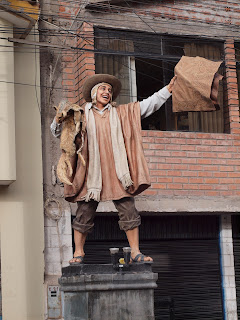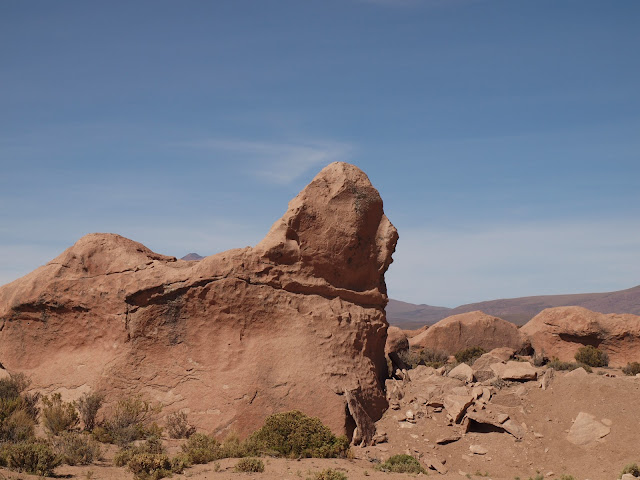Tuesday 4 December.
Only a short ride today, to Puno.
Hey driving practices are
just as bad here and speed limits really slow.
It was interesting just trundling along past the 300 meter
dogs looking at the various farming practices and use of the arable land next
to the lake. No fences to be seen anywhere with small plots of land ploughed by
cow drawn plough. Immediately next to that would be small herds of animals,
often mixed, with either a family member or dogs left to keep them from
wandering off. Hence the 300 meter dogs, which was about the frequency dogs
were stationed along the road edge to keep the stock in check. Some were tied
up but most just sat there.
If you want to move your stock and not have them scatter in
all directions, well all you do is just tie them all together. Drag he first
one, while other family members persuade the rest to follow.
Puno. The largest center on Lake Titikaka.
We managed to find our way into the middle of the city, despite
the maddening one way system, and found a reasonable hotel with secure parking
just off the central square by accidentally parking opposite while checking our
books on suitable accommodation.
There was a lot going on in Puno with bands playing, and
plenty of activity on the streets. A large stage was being set up to the side
of the square blocking the street to our hotel. We later learned it was a
festival to celebrate the police forces. So who was going to object? The
celebrations went on till about 2am with fireworks etc. The next day the
police, Army, Navy held there parades in the square.
Time for some repairs.
The Tenere headlight mounting frame had succumbed to the
severe shakings, broken completely on one side and cracked through on the
other. I managed to get it welded by an enthusiastic road-side mechanic. I
watched with some concern as he merrily welded the frame with sparks dropping
onto the plastic fuel tank!
Wed 5 December.
Time to be a tourist!
The Hotel had a resident travel agent who booked a half day
tour of the floating reed islands on Lake
Titikaka, a trip worth
doing.
Ours was a bit of a comedy show. After being collected from
the Hotel, run all over town, picking up other members of our party, we were
deposited at the local port and lead to a “really good boat” which appeared to
be in need of repairs. After braving the odds, stepping over the other boats
barged together, we all seated ourselves while Capitan explained to our guide
all was not ready. He was busy bucketing water, priming the engine cooling
system. The engine started and we were under way with the intrepid Capitan
hanging out the window checking water was passing through the cooling system.
Nope! 400 meters from the jetty, engine off, we floundered around while Capitan
made appropriate beating noises from down the back. Back he came, engine
started and turned off about the time we passengers were about to be
asphyxiated by exhaust fumes. Seems he had sucked plastic into the intake and
was working to clear it.
Success! On our way. The good boat ‘Faulty Tours’ proceeded
to weave its way across the Lake. Due to all
passengers loaded to the front of the boat, and a very small rudder, it was
unable to hold a straight course despite el Capitan throwing it lock to lock.
Once into the reed passage we bounced off either side. The
toll takers were obviously used to Faulty Tours arrival and sensible had a getaway boat set to go
should it appear all was lost and they were about to be run down.
How do you stop a boat with no reverse. Why you aim it where
you want to go, turn the engine off and ram whatever you aimed at … hopefully.
The toll collectors watched calmly as Faulty bounced off the reed bank just
short of there hut, and getaway boat, and proceeded to return to the main
channel. A toll collector grabbed a line thrown to him and bravely tried to
slow Faultys’ pace whilst being bodily dragged along a dwindling reed bank.
About the point he was about to experiment with bare-foot water sking, or keel
hauling, he let go. The toll must been passed as the engine started -
unfortunately dragging the light rope into the prop. Capitan just shrugged and
carried on.
Once out of the reed channel into the island area you are
the lead, by a pilot boat, to the Island you
intend to visit.. Now Faultys’ pace at idle was somewhat faster the Pilots’
tinny leading to first, a close ramming, and then Faulty leading the Pilot
boat. Much yelling ensued, the engine shut down and the Pilot taking the lead
again.
Circumstance lead to Faulty actually being aimed at the
correct Island so El Capitan gave it a
spirited handful of throttle. Judging by the alarmed Islanders who were about
to have there 6000m2 island moved to the North, a little too spirited!
Needless to say we arrived!
We were thoroughly entertained and educated about the island culture and
the reed Islands,
with demonstrations given on how the Islands
were built and maintained. At this time of year the islands are built up with
more reeds to compensate for the expected 1.5 m rise in lake level. We then had
the opportunity to take a ride on a reed catamaran, rowed by two Islanders, to
the main island. All started well but the wind was picking up and it turned
into a real slog for the two rowers.
Then it was back on Faulty to weave our way back to Puno.
The large dark block below the green reeds is a large mass of reed root system. once cut free of the lake bed it floats and is used to make the bulk of the Island mass.
Accommodation is basic but livable.
Part of the biggest Island in this group. Tin roof - cafe and "international coffee" they assure me.
Thurs 6 DEC
The hotel travel
agent seems to have “friends” everywhere. On hearing we were heading for Cusco,
plus our intention to visit Machu Picchu, he contacted his friends, arranged a
hotel with parking 5 mins walk from the central square in Cusco at a remarkable
good price. He then had his other travel agent friend in Cusco
organize a City Tour and a day at Machu Pichu. Again all was arranged for a
remarkable fair price.
All we had to do was get to Cusco.
The original intention was to stay off the main route
exploring some of the back roads. We received advise the back-roads were it
poor condition after recent rains so not such SSgood option. Main road it was,
with heavy traffic and suicide drivers becoming the norm. The road principally
follows cultivated river valleys dotted with numerous small settlements.
Arriving at Cusco about
1700 was a real eye opener. The traffic was chaotic.. Three lanes of traffic all
trying to cut each other off, and taxis trying to push us out of the way. We
made it to the central square and our Hotel after a lot of misdirection. Phew!
Fri 7 DEC
At last….a sleep-in then time to explore the city center. Cusco is a tourist hospot which the city centre caters
for with plenty of cafes/restaurants/bars, Artisan shops and dozens of travel
agents ready to relieve you of your cash.
The afternoon city tour takes in the city Cathedral and Inca
ruins within and outside the city limits. Outside the city 4 sites are visited,
the most remarkable, Sacsaywaman, is an excellent example of Inca construction
in local stone. See photos.
Sat 8 DEC
Groan..no sleep-in today. 04:00 start. Taxi, train and bus
to Machu Picchu.
We arrived at the Machu
Picchu site about 09:00 after a bus ride from Aguas
Calientes. Aguas Calientes is situated in a deep gorge below Machu Picchu.
After a 2 hour guided tour we were left to explore at will.
We have all seen the iconic photos of Machu
Picchu but until you see it for yourself you do not
appreciate how extensive the ruins are or the spectacular site selected to
build the sacred city. It is situated on a ridge between a mountain range, and
a single mountain, with massive drop-offs on either side. The original paths to
enter and leave the city are equally spectacular.
Here are a few photos’ but you need to see this for
yourselves.
Inca Bridge
Come a third down from the top of the Photo. The thin vegetation line running across the photo was the trail one trail out of Machu Picchu.





















































